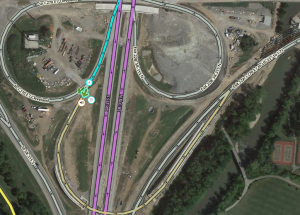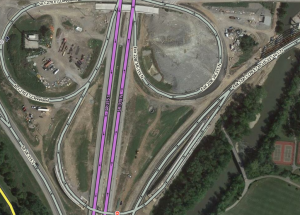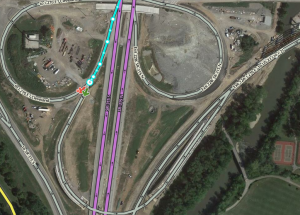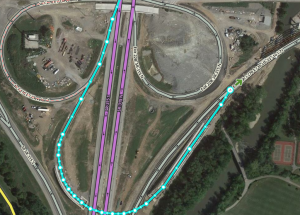Kartografer (talk | contribs) (added flowchart) |
Kartografer (talk | contribs) m (changed headings and added event subsection) |
||
| Line 1: | Line 1: | ||
In high-traffic areas, local governing authorities will often give advance notice regarding changes such as the opening of a new highway or interchange, the reconfiguration of a ramp or intersection, or a temporary construction detour over a new roadway or contraflow lane. With careful timing, Waze editors can proactively use this information to schedule routing changes in the area in order to minimize any potential disruptions to navigation. When a reconfiguration is simple enough not to significantly change routing, such as merely moving an exit a couple hundred feet, scheduling the change in WME is not necessary, and the map can simply be updated at the time of the change. However, when a reconfiguration is complex and significantly changes routing for a large number of people, it should be scheduled in advance. This article describes the procedure for implementing scheduled reconfigurations. | In high-traffic areas, local governing authorities will often give advance notice regarding changes such as the opening of a new highway or interchange, the reconfiguration of a ramp or intersection, or a temporary construction detour over a new roadway or contraflow lane. With careful timing, Waze editors can proactively use this information to schedule routing changes in the area in order to minimize any potential disruptions to navigation. When a reconfiguration is simple enough not to significantly change routing, such as merely moving an exit a couple hundred feet, scheduling the change in WME is not necessary, and the map can simply be updated at the time of the change. However, when a reconfiguration is complex and significantly changes routing for a large number of people, it should be scheduled in advance. This article describes the procedure for implementing scheduled reconfigurations. | ||
=Flowchart= | |||
[[File:Reconfig.png|800px]] | [[File:Reconfig.png|800px]] | ||
=Process= | |||
==Draw new roads== | ==Draw new roads== | ||
[[File:NewRamp.png|300px|right|thumb|The new ramp has been drawn at the bottom of the image, and a restriction has been added to it.]] | [[File:NewRamp.png|300px|right|thumb|The new ramp has been drawn at the bottom of the image, and a restriction has been added to it.]] | ||
| Line 15: | Line 16: | ||
* If this reconfiguration is temporary, set the closures to end whenever traffic is expected to revert to normal, and revisit the issue later. '''Do not continue to the last two sections'''. | * If this reconfiguration is temporary, set the closures to end whenever traffic is expected to revert to normal, and revisit the issue later. '''Do not continue to the last two sections'''. | ||
* If the reconfiguration is permanent, set the closures to end two weeks later. This will allow a cushion of time during which to finalize changes to the map. '''Continue to the last two sections''' | * If the reconfiguration is permanent, set the closures to end two weeks later. This will allow a cushion of time during which to finalize changes to the map. '''Continue to the last two sections''' | ||
===Create a major traffic event for push notifications=== | |||
==Restrict turns to old, unused roads== | ==Restrict turns to old, unused roads== | ||
Revision as of 20:50, 19 January 2017
In high-traffic areas, local governing authorities will often give advance notice regarding changes such as the opening of a new highway or interchange, the reconfiguration of a ramp or intersection, or a temporary construction detour over a new roadway or contraflow lane. With careful timing, Waze editors can proactively use this information to schedule routing changes in the area in order to minimize any potential disruptions to navigation. When a reconfiguration is simple enough not to significantly change routing, such as merely moving an exit a couple hundred feet, scheduling the change in WME is not necessary, and the map can simply be updated at the time of the change. However, when a reconfiguration is complex and significantly changes routing for a large number of people, it should be scheduled in advance. This article describes the procedure for implementing scheduled reconfigurations.
Flowchart
Process
Draw new roads

A week to three days in advance of the scheduled reconfiguration, draw and connect any new roads that will be open after the reconfiguration, and allow all turns for both the old and new configurations. Use time-based segment restrictions on the new segments to prevent routing until the opening day, and set the end date of the restriction to end the day before the opening day. This advance timing is necessary to allow for a tile update in order to use real-time closures on any road segments with new IDs. Do not conversely place any time-based restrictions on any currently open roads that will be closed after the reconfiguration, in case the reconfiguration is postponed. Where new road segments may create forks that trigger unnecessary turn instructions in either the old or new configurations, use turn instruction overrides to prevent instructions from being given. If necessary, add a map comment.
Add real-time closures

After a day or two, and before the change has occurred, check for a tile update. After the tile update, the new segment IDs will have been loaded into the closure database, and real-time closures can be added onto them.
Prevent new routes before reconfiguration
Remove time-based restrictions from the new segments, which will be unnecessary once closures are set. Add closures to new segments from the present time until the expected time that the new route will be open. In order to minimize confusion for drivers, instead of closing all new segments, only close segments that are necessary to prevent routing. This time will need to be adjusted if the time of the reconfiguration is changed.
Prevent old routes after reconfiguration
At this time, also add closures on any existing routes that will be closed after the reconfiguration. Set the closures to start according to the planned time announced by the governing authority in charge of the reconfiguration.
- If this reconfiguration is temporary, set the closures to end whenever traffic is expected to revert to normal, and revisit the issue later. Do not continue to the last two sections.
- If the reconfiguration is permanent, set the closures to end two weeks later. This will allow a cushion of time during which to finalize changes to the map. Continue to the last two sections
Create a major traffic event for push notifications
Restrict turns to old, unused roads

After the reconfiguration has occurred, restrict turns to any old roads that are no longer used. This will prevent routing after a tile update, even if the real-time closures on such roads are deleted or expire. Using turn restrictions is necessary, rather than segment restrictions, disconnection or deletion of old roads, because closures must be maintained to prevent routing until the tile update.
Remove closures and clean old roads from the map

After a tile update puts the new turn restrictions into effect, remove real-time closures on old roads. If any intersections are permanently blocked, such as when an interchange replaces an intersection, disconnect the roads that no longer route through the intersection. If any roads are permanently closed and removed from service, never to return again to use, delete them from the map. Also delete unnecessary junction nodes and geometry nodes. Check GPS tracks to see if the new traffic configuration is starting to be recorded, and use it to adjust alignment of the roads accordingly.
